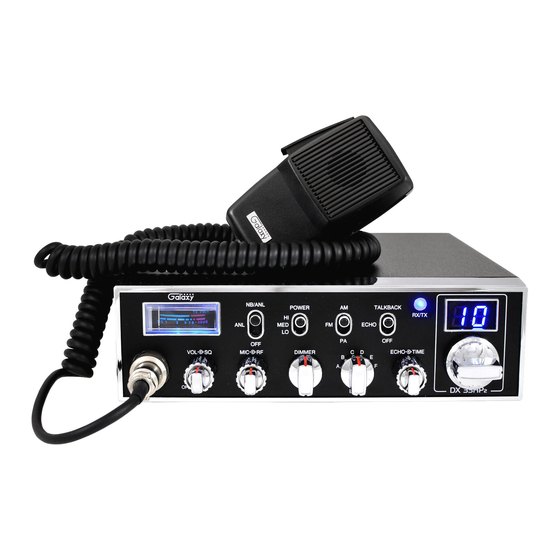Galaxy DX 33HP2 Kullanıcı El Kitabı - Sayfa 5
Alıcı-Verici Galaxy DX 33HP2 için çevrimiçi göz atın veya pdf Kullanıcı El Kitabı indirin. Galaxy DX 33HP2 8 sayfaları. 10 meter amateur mobile transceiver

Operation
CONTROL FUNCTIONS
There are thirteen controls and three indicators on the front panel of your
transceiver.
FRONT PANEL
1. MICROPHONE JACK. Used to connect microphone for voice source.
2. OFF/ON/VOLUME (inner dual concentric). Turn clockwise to apply power
to the unit and to set the desired listening level. During normal operation, the
VOLUME control is used to adjust the output level obtained either at the
transceiver speaker or the external speaker, if used.
3. SQUELCH (outer dual concentric). This control is used to cut off or
eliminate receiver background noise in the absence of an incoming signal. For
maximum receiver sensitivity it is desired that the control be adjusted only to
the point where the receiver background noise or ambient background noise is
eliminated. Turn fully counterclockwise then slowly clockwise until the
receiver noise disappears. Any signal to be received must now be slightly
stronger than the average received noise. Further clockwise rotation will
increase the threshold level which a signal must overcome in order to be heard.
Only strong signals will be heard at a maximum clockwise setting.
4. MIC GAIN (inner dual concentric). Adjust the microphone gain in transmit
and PA modes. This controls the gain to the extent that full talk power is
available several inches away from the microphone.
5. RF GAIN CONTROL (outer dual concentric). Use to reduce the gain of the
receive signal under strong signal conditions.
- 7 -
6. DIMMER CONTROL. Controls the brightness of the meter lamp, channel
display digits and RX/TX LED.
7. BAND SELECTOR. This switch is used to select the band.
8. ECHO. This control is used to set the amount of the echo effect.
9. TIME. This control is used to set the interval of the echo effect.
10. CHANNEL SELECTOR. This switch selects any one of the forty channels
desired. The selected channel number is on the LED readout directly above the
Channel Selector knob.
11. METER. Indicates received signal strength and transmitter RF output power.
12. NB/ANL/OFF. In the ANL position, the Automatic Noise Limiter circuit is
activated. In the NB/ANL position, the RF Noise Blanker is also activated.
This Noise Blanker is very effective for repetitive impulse noise such as
ignition interference. Both ANL and NB are off when this switch is in "OFF".
13. RF POWER. This switch is used to select transmitting power. In the HI
position, the transceiver operates at 10 watts RF output power. In the MED
position, the transceiver operates 3 watts RF output power. In the LO position,
the transceiver operates in 0.5 watts RF output power.
14. MODE (PA/FM/AM) SWITCH. This switch is used to select PA, FM, AM
mode of operation. When you set to PA position, the transceiver acts as a
public address amplifier. Before operating PA, you must first connect an
external PA speaker (8 ohm, 4-watt) to the PA Speaker jack on the unit rear
panel.
15. TALKBACK/ECHO/OFF. When this switch is in the TALKBACK position,
it is used to monitor your own voice in the radio speaker. For example, you
could use this feature to compare different Microphones. When in the ECHO
position, it will add an echo effect to your voice. Both Echo and Talkback are
off when this switch is in the OFF position.
16. RECEIVE/TRANSMIT INDICATOR. The receiver/transmit LED indicator
is located next to the channel indicator. When in receive, the LED will be blue.
When in transmit the LED will be red.
17. CHANNEL INDICATOR. Numbered LED indicates the selected channel
you wish to operate on.
-8-
